The iPhone 17 Air has ignited excitement not seen since the iPhone X, delivering a futuristic design that feels like a glimpse into Apple’s foldable future. After 30 days of rigorous testing—from bustling London streets to cozy Netflix marathons—I’m unexpectedly smitten with this ultra-slim marvel. Priced at $999, it sits between the iPhone 17 ($799) and the 17 Pro/Pro Max in Apple’s 2025 lineup, blending premium aesthetics with compromises that demand scrutiny.
With a 5.6 mm titanium frame, a 6.5-inch Goldilocks display, a powerful A19 Pro chip, and a revolutionary 18 MP square selfie camera, the Air feels like a concept phone you can actually buy. But does its style justify the trade-offs?
Quick Verdict: The iPhone 17 Air’s breathtaking design, perfect screen size, and stellar selfie camera make it a standout, but its single rear camera and premium price require careful consideration for power users.
Key Specs Snapshot:
| Feature | Details |
|---|---|
| Price | $999 |
| Screen Size | 6.5-inch ProMotion OLED (1–120 Hz) |
| Weight | 20% lighter than iPhone 17 Pro (~165 g) |
| Thickness | 5.6 mm |
| Chip | A19 Pro (5-core GPU, 12 GB RAM) |
| Storage | 256 GB (base), up to 1 TB |
| Camera | 48 MP main, 18 MP square selfie |
| Battery | ~27 hours video playback (40 with MagSafe charger) |
| Colors | Light Gold, Space Black, Sky Blue |
| Durability | IP68, Ceramic Shield 2 |
| Connectivity | eSIM-only, 5G mmWave, C1X modem |
First Impressions & Unboxing
Unboxing the iPhone 17 Air feels like opening a portal to Apple’s future. The sleek, minimalist packaging includes a USB-C to USB-C cable, a SIM eject tool (for regions with physical SIMs in other models), and eco-friendly documentation, aligning with Apple’s sustainability efforts. Notably absent is the $100 MagSafe charger, a premium accessory that enhances the Air’s battery life but requires a separate purchase.
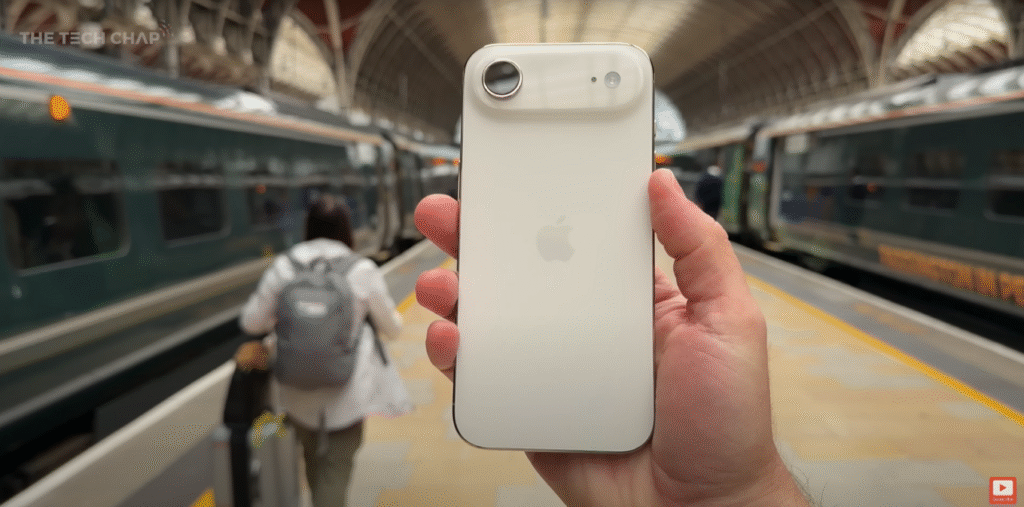
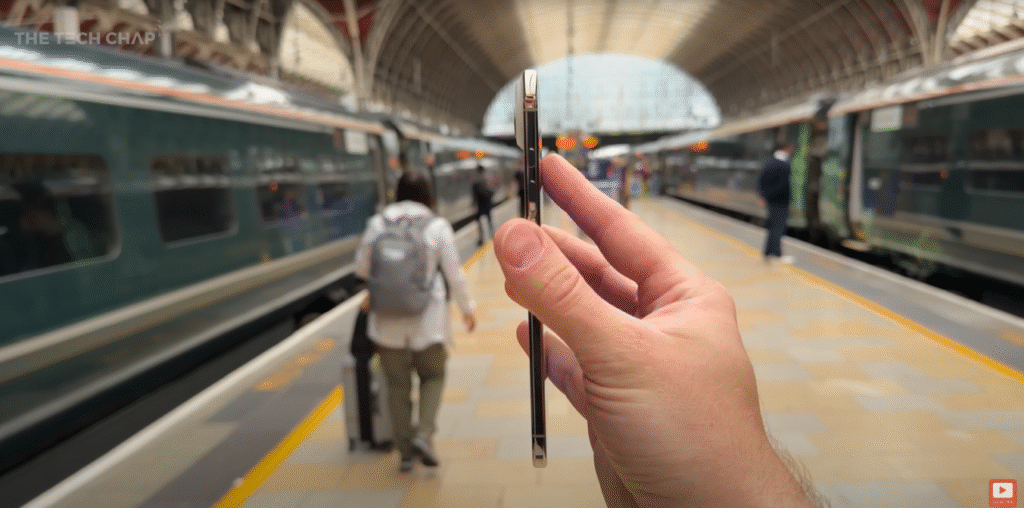
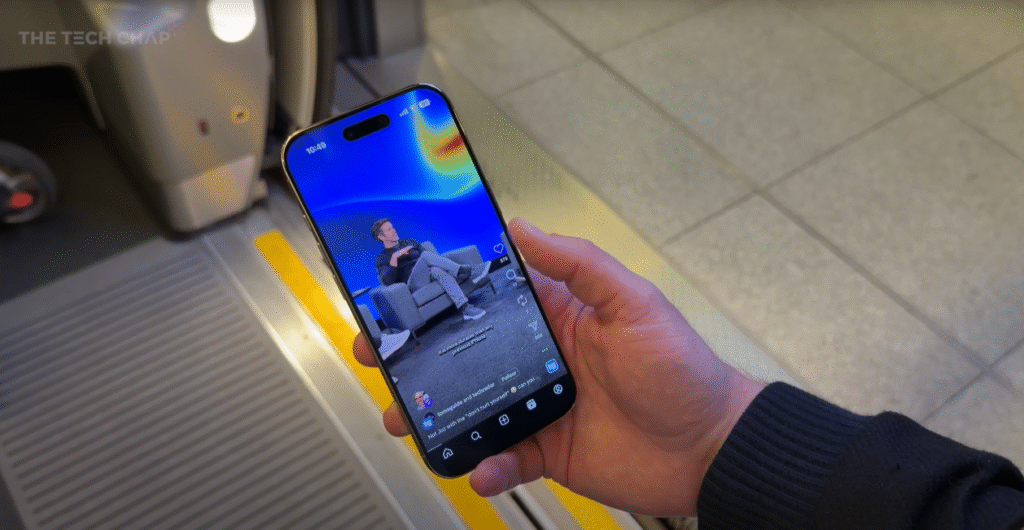
Holding the Air for the first time is a wow moment—its 5.6 mm thickness and 20% lighter weight compared to the iPhone 17 Pro (approximately 165 g vs. 206 g) evoke smiles, much like the iPhone 4 or X did in their eras. Apple’s design philosophy here is clear: create a phone that feels like a concept device, blending portability with premium craftsmanship, setting the stage for a potential foldable iPhone in 2026.
The Air’s titanium frame and vibrant color options—Light Gold, Space Black, and Sky Blue—exude luxury. The Light Gold, nearly indistinguishable from Cloud White, feels redundant, but the Sky Blue’s vibrant hue steals the spotlight, turning heads in public. After 30 days, the Air’s futuristic vibe remains a conversation starter, especially among those craving something fresh from Apple’s often iterative designs.
Design & Build Quality
At 5.6 mm, the iPhone 17 Air is Apple’s thinnest iPhone ever, edging out Samsung’s Galaxy Edge (5.8 mm) and making the iPhone 17 Pro feel bulky by comparison (36% thinner, 20% lighter). The polished titanium frame, unlike the matte aluminum of the iPhone 17 and Pro models, is a fingerprint magnet but surprisingly grippy, reducing the need for a case in daily use. Apple’s decision to stick with titanium (vs. aluminum’s better heat dissipation) prioritizes premium aesthetics, though it impacts thermal performance, as we’ll explore later.
Durability is a critical concern for such a thin device, especially after the iPhone 6’s “bend gate” saga. Apple’s internal testing, witnessed at Apple Park, involved a machine applying pressure to the Air’s chassis. The phone flexed noticeably—mimicking skyscrapers designed to sway in earthquakes—but didn’t crack or warp. After 30 days of pocket carry, commuting, and accidental drops onto soft surfaces, the Air showed no signs of damage, retaining its IP68 water and dust resistance. The 1 mm bumper case, a nostalgic nod to the iPhone 4/5, protects the edges while keeping the slim profile intact, though the exposed camera lens remains vulnerable.
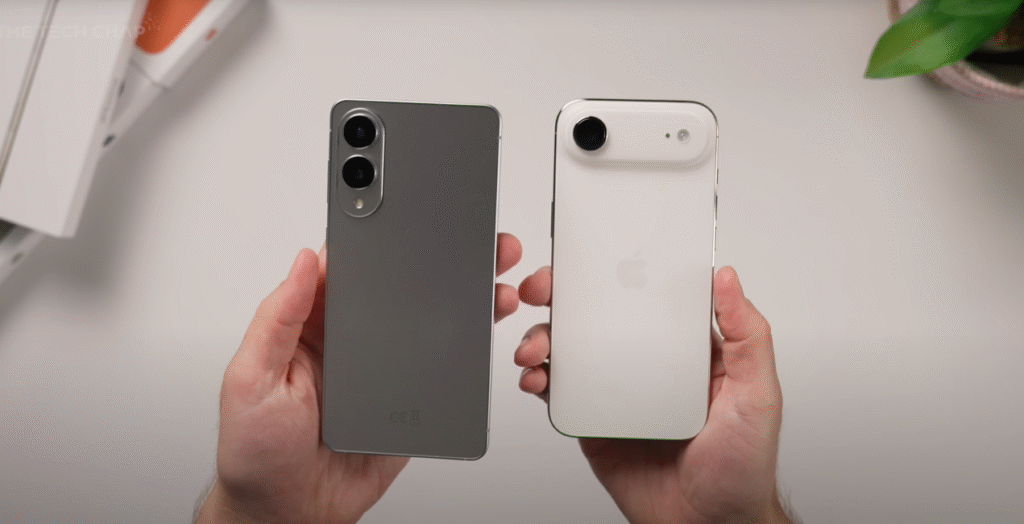
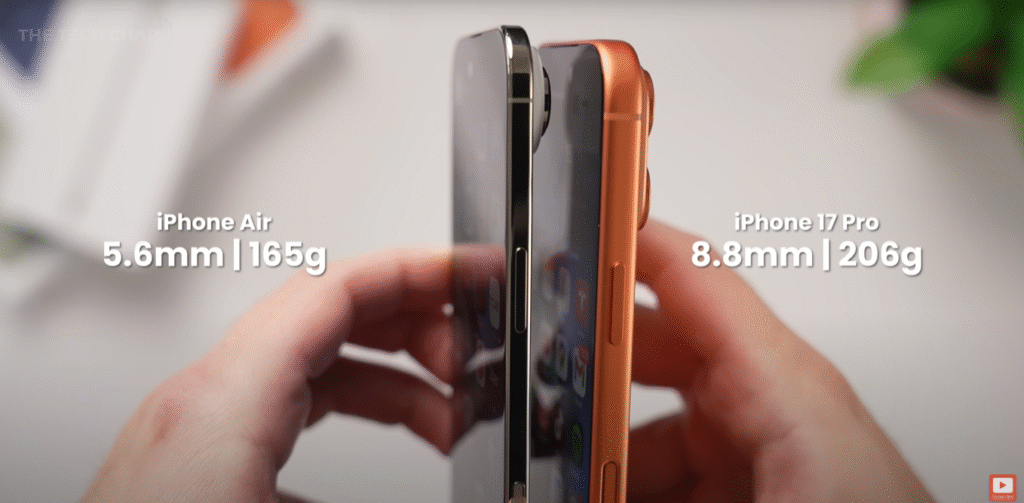
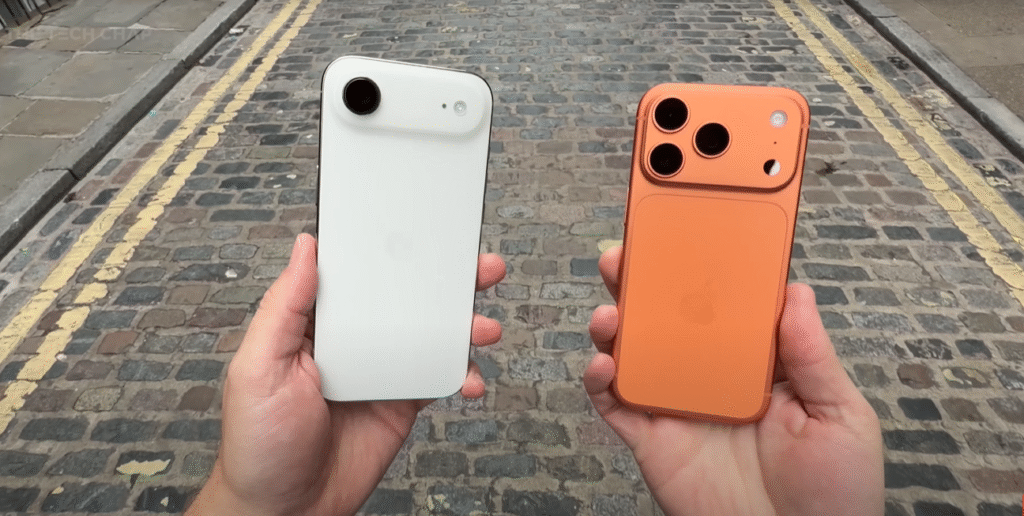
Color-wise, Sky Blue is the standout, offering a vibrant, modern aesthetic, while Space Black exudes understated elegance. Light Gold, while sleek, feels too similar to Cloud White, making Apple’s color naming questionable. The Action button and camera control are retained, though the latter feels underutilized, serving more as a novelty than a daily necessity.
Display & Multimedia Experience
The 6.5-inch ProMotion OLED is the Air’s defining feature, earning the “Goldilocks” moniker for its perfect balance. It’s 0.2 inches larger than the iPhone 17 and 0.4 inches smaller than the Pro Max, making it ideal for one-handed texting yet spacious enough for immersive Netflix binges or gaming sessions. With a 1–120 Hz refresh rate, scrolling is buttery smooth, and the 3,000-nit peak brightness (up from 2,000 nits on the iPhone 16 series) ensures readability in direct sunlight, rivaling premium Androids like the Galaxy S25 Ultra.
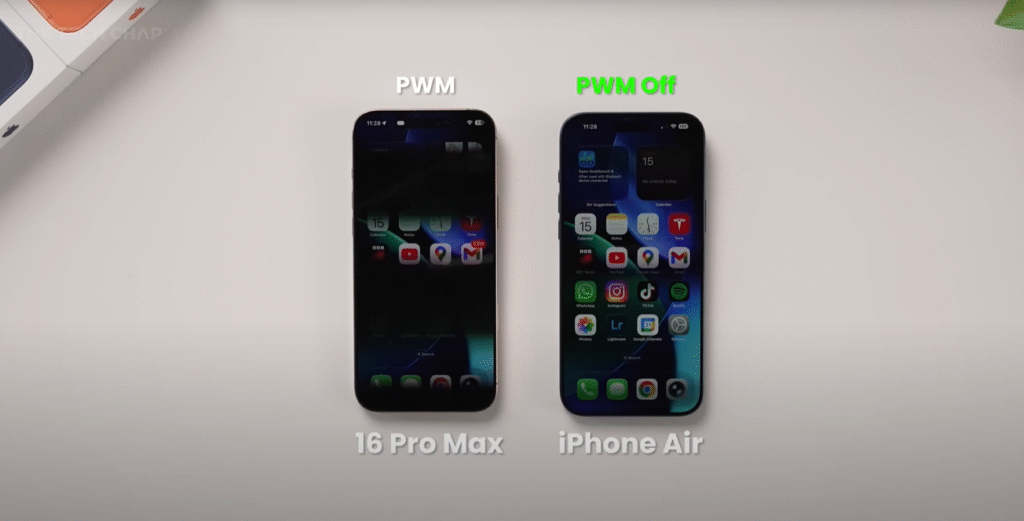
The Ceramic Shield 2 glass enhances scratch resistance—no micro-scratches appeared after 30 days, even without a screen protector. A 30% improved anti-reflective layer reduces glare compared to the iPhone 16 Pro Max, though Samsung’s S25 Ultra remains the gold standard for reflection control. A groundbreaking feature is the PWM flicker toggle, addressing OLED flicker that causes eye strain or headaches for sensitive users. While toggling it slightly impacts color accuracy at low brightness, it’s a game-changer for accessibility, making the Air a thoughtful choice for long screen-time sessions.
For multimedia, the display excels, rendering vibrant colors and deep blacks for shows like Stranger Things or games like Genshin Impact. However, the single earpiece speaker is a significant drawback, delivering one-sided audio that lacks the stereo depth of dual-speaker setups on the iPhone 17 or Pros. Watching videos feels slightly underwhelming without external audio solutions like AirPods Pro 3, which pair seamlessly to restore immersion. Outdoor readability and gaming performance are top-notch, but the speaker limitation keeps the multimedia experience from perfection.
Performance After 30 Days
The A19 Pro chip (5-core GPU, one less than the Pro models) powers the Air with 12 GB RAM (up from 8 GB last year) and 256 GB base storage, a welcome upgrade across the 2025 lineup. Geekbench tests show the Air outperforming the iPhone 16 Pro Max in single-core tasks, matching the iPhone 17, and trailing the 17 Pro/Pro Max by ~5% in multi-core performance. Graphics performance lags the Pros by ~20% due to the reduced GPU core, but it’s still faster than most Androids at $999, including the Galaxy S25 Ultra.
Daily tasks—app switching, 4K video editing, and AI-driven features like Siri enhancements—feel instantaneous. The Air handles multitasking with ease, supporting iOS 26’s local AI tasks (e.g., photo editing, text generation) without hiccups. However, gaming on demanding titles like War Thunder at max settings reveals limitations. The top-plateau design, housing the chip, camera, and speaker, concentrates heat, making the top edge toasty after 10–20 minutes. Without a vapor chamber (unlike the Pros), throttling reduces performance by ~5% in 3D Mark Solar Bay Extreme tests. Holding the phone sideways during gaming makes one hand sweatier, though vertical use mitigates this. Compared to the iPhone 17 (hotter overall) and Pros (better heat dissipation), the Air’s thermal management is a trade-off for its slimness.
After 30 days, the Air remains a powerhouse for casual users but falls short for hardcore gamers or creators pushing sustained performance. Its efficiency-focused design ensures snappy everyday use, making it future-proof for most scenarios.
Battery Life & Charging
Apple claims 27 hours of local video playback, extendable to 40 hours with the $100 MagSafe charger. My 30-day tests validate this: 10 hours of YouTube streaming at medium brightness left the Air at 49%, matching the iPhone 17 but trailing the 17 Pro (58%) and Pro Max (63%). A 1-hour War Thunder session at max settings dropped it to 71%, on par with the iPhone 17. A full drain test (Wi-Fi, eSIM, mixed apps) confirmed the Air lasts slightly less than the 17, but the gap is minimal.
The C1X modem enhances 5G efficiency, and iOS 26’s adaptive power mode learns usage patterns to optimize battery life, though its impact is hard to quantify in a month. 25 W wired and MagSafe wireless charging are adequate, fully charging the Air in ~90 minutes. The MagSafe charger, a sleek, low-profile accessory, adds significant battery life without adding bulk, making it ideal for travelers. However, long-term battery health is a concern—my iPhone 16 Pro Max dropped to 92% capacity after 331 cycles, suggesting the Air may dip to 85–90% after 1–2 years, requiring strategic charging habits or the MagSafe accessory.
Cameras: Front & Rear
Selfie Camera – A Game-Changing Upgrade
The 18 MP square selfie camera is a highlight, boasting a doubled sensor size and a 20 mm wide-angle FOV (vs. 23 mm on the iPhone 16). It captures sharper details, vibrant colors, and accurate skin tones, even in low light. Video stabilization is a massive leap—jogging tests at 4K 60 fps showed buttery-smooth footage compared to the 16 Pro Max’s shakier output. The auto-zoom and auto-rotate features simplify group selfies, automatically adjusting orientation without flipping the phone. Dual capture mode, recording front and rear video simultaneously, is fun for vloggers but capped at 4K 30 fps and saves as a single file (unlike Samsung’s separate outputs). Minor stabilization glitches in iOS 26 surfaced during testing, but Apple is likely to address these in updates.
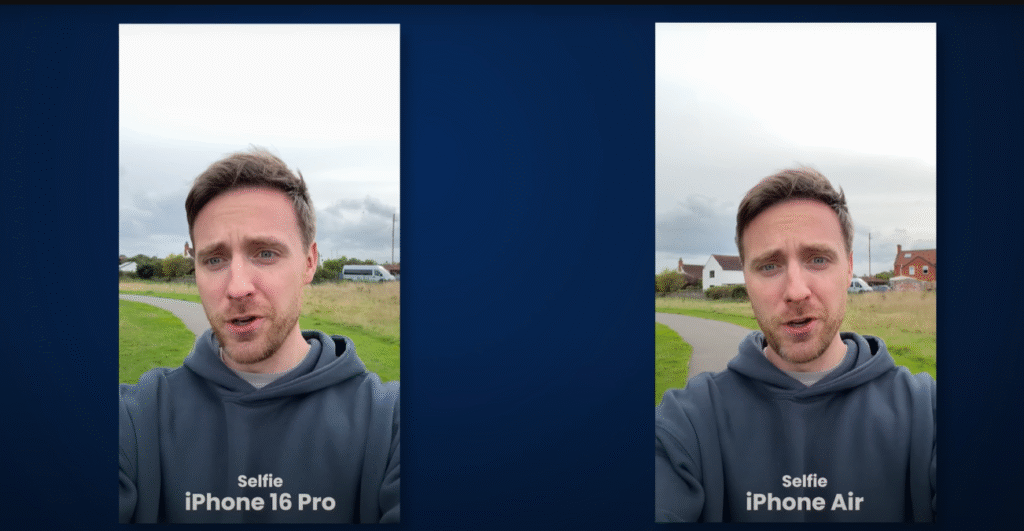
Rear Camera – Single but Reliable
The 48 MP main camera mirrors the iPhone 17’s sensor, delivering crisp daytime shots and decent low-light performance. Compared to the 17 Pro/Pro Max’s larger sensor, it falls short in texture and dynamic range, especially at night or in challenging lighting. The 2x machine-learning zoom produces near-optical portrait shots, but beyond 2x, quality degrades. Missing ultrawide, telephoto, ProRes, ProRAW, and 4K120 video limits its appeal for creators. Lens flare remains a persistent iPhone issue, occasionally marring shots with bright light sources. While reliable for everyday photography, the single-lens setup feels underwhelming at $999, especially against the Galaxy S25 Ultra’s 200 MP sensor and ultrawide lens.
Software & Features
iOS 26 brings a redesigned camera app, requiring a learning curve but offering intuitive controls for photo and video settings. The eSIM-only design (global) streamlines 5G connectivity via the C1X modem, delivering stable mmWave and sub-6 GHz performance in urban areas. However, users reliant on physical SIMs may face inconvenience, especially in regions with limited eSIM support. The Action button supports customizable shortcuts (e.g., flashlight, camera), while the camera control feels gimmicky, rarely used beyond initial testing. Apple’s 5-year OS update commitment ensures the Air remains relevant through 2030, supporting future AI and AR features.
Accessories & Ecosystem
The $100 MagSafe charger is a stylish, travel-friendly add-on, boosting battery life by 65% and fitting easily in a bag. The 1 mm bumper case protects the titanium edges while preserving the Air’s slimness, though the protruding camera lens remains exposed. Pairing with AirPods Pro 3 enhances audio quality, compensating for the single speaker’s limitations. Apple’s ecosystem—iCloud, AirDrop, Continuity—integrates seamlessly, making the Air a natural fit for Apple Watch, Mac, or iPad users.
Pros & Cons After 30 Days
Pros:
- Stunning 5.6 mm titanium design, 36% thinner and 20% lighter than 17 Pro
- 6.5-inch Goldilocks display with ProMotion, 3,000 nits, and PWM flicker toggle
- Exceptional 18 MP selfie camera with superior stabilization and dual capture
- Flagship A19 Pro chip with 12 GB RAM, snappy for daily tasks and AI
- 27-hour battery life, extendable to 40 with MagSafe charger
Cons:
- Single 48 MP rear camera lacks ultrawide, telephoto, and Pro-level features
- Single earpiece speaker delivers one-sided audio, limiting immersion
- No ProRes, ProRAW, or 4K120 video, disappointing for creators
- Heat buildup in top plateau during extended gaming, with minor throttling
- $999 price feels steep vs. iPhone 17’s $799 for similar performance
Competitor Comparison
- iPhone 17 ($799): Offers an ultrawide lens, dual speakers, and comparable performance at a lower price, making it the better value for most.
- iPhone 17 Pro/Pro Max: Superior cameras, vapor chamber cooling, and an extra GPU core cater to power users, justifying their premium.
- Samsung Galaxy S25 Ultra: Boasts a 200 MP camera, ultrawide lens, and best-in-class anti-reflective screen, outshining the Air in photography.
- Samsung Galaxy Edge: Matches thinness (5.8 mm) with dual cameras and speakers, offering a more balanced feature set at a similar price.
Who Should Buy the iPhone 17 Air
The iPhone 17 Air is perfect for style-conscious buyers, frequent travelers, and content creators who value portability, a stunning 6.5-inch display, and a top-tier selfie camera for vlogging or social media. Its head-turning design and lightweight build make it ideal for those who prioritize aesthetics and one-handed use. Power users needing pro-level cameras, stereo audio, or extended gaming performance should opt for the iPhone 17 Pro or Galaxy S25 Ultra.
Verdict: Living With the iPhone 17 Air for 30 Days
Final Score: 8.7/10
- Design: 9.5/10 – Ultra-thin, durable, and grippy; a futuristic masterpiece.
- Performance: 8.5/10 – Flagship speed with minor gaming throttling.
- Camera: 8.2/10 – Stellar selfie, reliable main, but limited versatility.
- Value: 7.8/10 – Premium price demands weighing compromises vs. style.
Should You Upgrade? If you’re upgrading from an iPhone 16 or older and crave a sleek, futuristic device, the Air is a compelling choice. Pro users or gamers should stick with the 17 Pro for better cameras and cooling. The Air feels like Apple’s bold step toward a foldable future, blending style, portability, and enough power to satisfy most users. Pair it with the MagSafe charger and AirPods Pro 3 for the ultimate experience.
Yes, it’s eSIM-only globally, leveraging the C1X modem for stable 5G mmWave and sub-6 GHz connectivity, but physical SIM users may face challenges.
Yes, the Air supports mmWave, delivering fast speeds in supported urban areas, with consistent performance during 30 days of testing.
Comparison Table: iPhone 17 Air vs. Competitors
| Feature | iPhone 17 Air | iPhone 17 | iPhone 17 Pro | Galaxy S25 Ultra |
|---|---|---|---|---|
| Price | $999 | $799 | $1,199 | ~$1,099 |
| Thickness | 5.6 mm | 7.8 mm | 8.2 mm | 8.1 mm |
| Cameras | 48 MP main, 18 MP selfie | 48 MP main, ultrawide, 18 MP selfie | 48 MP main, ultrawide, telephoto, 18 MP selfie | 200 MP main, ultrawide, telephoto |
| Speakers | Single earpiece | Dual | Dual | Dual |
| Battery | 27 hours (40 with MagSafe) | 28 hours | 30 hours | 35 hours |
| Chip | A19 Pro (5-core GPU) | A19 | A19 Pro (6-core GPU) | Snapdragon 8 Elite |
Author Section: Hello! I’m Tom, and I run one of the UK’s biggest technology content creators. I test and review the latest Phones, Laptops, TVs, PC Hardware, Cars & More – to help you make the right buying decision! New videos are posted weekly, and I share many more on Instagram & TikTok! Cheers!
Next blog: iPhone 17 Air Durability Test




[…] the iPhone 17 Air feels like opening a premium gift box. Apple’s minimalist packaging includes a USB-C cable […]